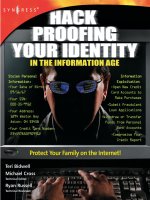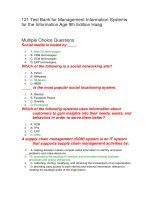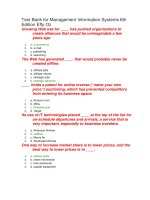Ethics for the information age 6th global edtion quinn
Bạn đang xem bản rút gọn của tài liệu. Xem và tải ngay bản đầy đủ của tài liệu tại đây (7.32 MB, 551 trang )
www.downloadslide.com
GlobAl
EdItIon
Ethics for the
Information Age
SIXth EdItIon
Michael J. Quinn
www.downloadslide.com
Global Edition
www.downloadslide.com
This page is intentionally left blank.
www.downloadslide.com
Global Edition
www.downloadslide.com
Editorial Director, ECS Marcia Horton
Head of Learning Asset Acquisition, Global Edition Laura Dent
Acquisitions Editor Matt Goldstein
Program Manager Kayla Smith-Tarbox
Director of Marketing Christy Lesko
Marketing Manager Yezan Alayan
Marketing Assistant Jon Bryant
Director of Production Erin Gregg
Senior Managing Editor Scott Disanno
Acquisitions Editor, Global Edition Murchana Borthakur
Associate Project Editor, Global Edition Binita Roy
Project Manager Camille Trentacoste
Manufacturing Buyer Linda Sager
Senior Manufacturing Controller, Production, Global Edition Trudy Kimber
Text Designer Sandra Rigney
Manager, Text Permissions Tim Nicholls
Text Permission Project Manager William Opaluch
Cover Image © Tom Wang. Shutterstock
Media Project Manager Renata Butera
Full-Service Project Management Cypress Graphics, Paul C. Anagnostopoulos
Credits and acknowledgments borrowed from other sources and reproduced, with permission,
appear on the appropriate page in the text.
Pearson Education Limited
Edinburgh Gate
Harlow
Essex CM20 2JE
England
and Associated Companies throughout the world
Visit us on the World Wide Web at: www.pearsonglobaleditions.com
© Pearson Education Limited 2015
The rights of Michael J. Quinn to be identified as the author of this work have been asserted by
him in accordance with the Copyright, Designs and Patents Act 1988.
Authorized adaptation from the United States edition, entitled Ethics for the Information Age, 6th
edition, ISBN 978-0-13-374162-9, by Michael J. Quinn, published by Pearson Education © 2015.
All rights reserved. No part of this publication may be reproduced, stored in a retrieval system,
or transmitted in any form or by any means, electronic, mechanical, photocopying, recording or
otherwise, without either the prior written permission of the publisher or a license permitting
restricted copying in the United Kingdom issued by the Copyright Licensing Agency Ltd, Saffron
House, 6–10 Kirby Street, London EC1N 8TS.
Many of the designations by manufacturers and sellers to distinguish their products are claimed
as trademarks. Where those designations appear in this book, and the publisher was aware of a
trademark claim, the designations have been printed in initial caps or all caps.
All trademarks used herein are the property of their respective owners. The use of any trademark
in this text does not vest in the author or publisher any trademark ownership rights in such
trademarks, nor does the use of such trademarks imply any affiliation with or endorsement of this
book by such owners.
ISBN 10: 1-292-06123-5 ISBN 13: 978-1-292-06123-8 (Print) ISBN 13: 978-1-292-06190-0 (PDF)
British Library Cataloguing-in-Publication Data
A catalogue record for this book is available from the British Library
14 13 12 11 10 9 8 7 6 5 4 3 2 1
Typeset in Minion and Nofret by Cypress Graphics.
Printed and bound by Courier Westford in The United States of America.
www.downloadslide.com
Brief Contents
Preface 21
1
Catalysts for Change
29
An Interview with Dalton Conley 75
2
Introduction to Ethics
77
An Interview with James Moor 133
3
Networked Communications
137
An Interview with Michael Liebhold 187
4
Intellectual Property
189
An Interview with June Besek 251
5
Information Privacy
255
An Interview with Michael Zimmer 293
6
Privacy and the Government
297
An Interview with Jerry Berman 343
7
Computer and Network Security
An Interview with Matt Bishop 385
8
Computer Reliability
389
An Interview with Avi Rubin 433
9
Professional Ethics
435
An Interview with Paul Axtell 475
10
Work and Wealth
479
An Interview with Martin Ford 519
Appendix A: Plagiarism
Index 527
523
347
www.downloadslide.com
This page is intentionally left blank.
www.downloadslide.com
Contents
Preface 21
1
Catalysts for Change
1.1
Introduction
1.2
Milestones in Computing
1.2.1
1.2.2
1.2.3
1.2.4
1.2.5
1.2.6
1.2.7
1.2.8
1.2.9
1.2.10
1.2.11
1.3
30
33
Aids to Manual Calculating 33
Mechanical Calculators 34
Cash Register 36
Punched-Card Tabulation 37
Precursors of Commercial Computers 39
First Commercial Computers 41
Programming Languages and Time-Sharing
Transistor and Integrated Circuit 43
IBM System/360 45
Microprocessor 45
Personal Computer 46
Milestones in Networking
1.3.1
1.3.2
1.3.3
1.3.4
1.3.5
1.3.6
1.3.7
1.3.8
1.3.9
1.3.10
1.3.11
1.3.12
1.3.13
29
49
Electricity and Electromagnetism 49
Telegraph 51
Telephone 52
Typewriter and Teletype 53
Radio 53
Television 54
Remote Computing 56
ARPANET 56
Email 57
Internet 57
NSFNET 59
Broadband 59
Wireless Networks 59
42
www.downloadslide.com
8
Contents
1.4
Milestones in Information Storage and Retrieval
1.4.1
1.4.2
1.4.3
1.4.4
1.4.5
1.4.6
1.4.7
1.4.8
1.4.9
1.5
Greek Alphabet 60
Codex and Paper 60
Gutenberg’s Printing Press 61
Newspapers 61
Hypertext 61
Graphical User Interface 62
Single-Computer Hypertext Systems 64
Networked Hypertext: World Wide Web 64
Search Engines 65
Information Technology Issues 66
Summary
67
Review Questions 69
Discussion Questions
70
In-Class Exercises 71
Further Reading and Viewing 72
References 72
An Interview with Dalton Conley 75
2
Introduction to Ethics
2.1
Introduction
2.1.1
2.1.2
2.1.3
2.2
2.3
2.6
84
86
The Case for Cultural Relativism 87
The Case against Cultural Relativism 88
93
The Case for Ethical Egoism 93
The Case against Ethical Egoism 94
Kantianism
2.6.1
2.6.2
90
The Case for the Divine Command Theory 90
The Case against the Divine Command Theory 91
Ethical Egoism
2.5.1
2.5.2
83
The Case for Subjective Relativism 84
The Case against Subjective Relativism 85
Divine Command Theory
2.4.1
2.4.2
2.5
Defining Terms 78
Four Scenarios 80
Overview of Ethical Theories
Cultural Relativism
2.3.1
2.3.2
2.4
77
Subjective Relativism
2.2.1
2.2.2
77
95
Good Will and the Categorical Imperative 96
Evaluating a Scenario Using Kantianism 98
60
www.downloadslide.com
Contents
2.6.3
2.6.4
2.7
Act Utilitarianism
2.7.1
2.7.2
2.7.3
2.7.4
2.8
100
Principle of Utility 101
Evaluating a Scenario Using Act Utilitarianism
The Case for Act Utilitarianism 103
The Case against Act Utilitarianism 104
Rule Utilitarianism
2.8.1
2.8.2
2.8.3
2.8.4
2.9
The Case for Kantianism 99
The Case against Kantianism 99
106
Basis of Rule Utilitarianism 106
Evaluating a Scenario Using Rule Utilitarianism 106
The Case for Rule Utilitarianism 107
The Case against Utilitarianism in General 108
Social Contract Theory
2.9.1
2.9.2
2.9.3
2.9.4
2.9.5
109
The Social Contract 109
Rawls’s Theory of Justice 111
Evaluating a Scenario Using Social Contract Theory
The Case for Social Contract Theory 114
The Case against Social Contract Theory 115
2.10 Virtue Ethics
2.10.1
2.10.2
2.10.3
2.10.4
117
Virtues and Vices 117
Making a Decision Using Virtue Ethics
The Case for Virtue Ethics 120
The Case against Virtue Ethics 121
119
2.11 Comparing Workable Ethical Theories
2.12 Morality of Breaking the Law
2.12.1
2.12.2
2.12.3
2.12.4
2.12.5
102
124
Social Contract Theory Perspective 124
Kantian Perspective 124
Rule Utilitarian Perspective 125
Act Utilitarian Perspective 125
Conclusion 126
Summary 126
Review Questions 127
Discussion Questions
129
In-Class Exercises
130
Further Reading and Viewing
References 131
131
An Interview with James Moor 133
122
113
9
www.downloadslide.com
10
Contents
3
Networked Communications
3.1
Introduction
3.2
Spam
3.2.1
3.2.2
3.2.3
3.3
3.4
150
Direct Censorship 150
Self-Censorship 151
Challenges Posed by the Internet 152
Government Filtering and Surveillance of Internet Content 152
Ethical Perspectives on Censorship 153
155
History 155
Freedom of Expression Not an Absolute Right
FCC v. Pacifica Foundation 157
Case Study: Kate’s Blog 158
160
165
Identity Theft 165
Chat-Room Predators 166
Ethical Evaluations of Police Sting Operations 167
False Information 169
Cyberbullying 170
Internet Addiction
3.9.1
3.9.2
156
Web Filters 160
Child Internet Protection Act 161
Ethical Evaluations of CIPA 162
Sexting 163
Breaking Trust
3.8.1
3.8.2
3.8.3
3.8.4
3.8.5
3.9
Transforming Lives in Developing Countries 148
Twitter 149
Business Promotion 149
Political Activism 149
Children and Inappropriate Content
3.7.1
3.7.2
3.7.3
3.7.4
3.8
148
Freedom of Expression
3.6.1
3.6.2
3.6.3
3.6.4
3.7
145
The World Wide Web 145
The Rise of the App 145
How We Use the Internet 145
Censorship
3.5.1
3.5.2
3.5.3
3.5.4
3.5.5
3.6
139
The Spam Epidemic 140
Need for Social-Technical Solutions 141
Case Study: Ann the Acme Accountant 142
Text Messaging
3.4.1
3.4.2
3.4.3
3.4.4
3.5
137
Internet Interactions
3.3.1
3.3.2
3.3.3
137
171
Is Internet Addiction Real? 171
Contributing Factors 173
www.downloadslide.com
Contents
3.9.3
Ethical Evaluation of Internet Addiction 174
Summary 175
Review Questions 176
Discussion Questions
177
In-Class Exercises
179
Further Reading and Viewing
References 181
180
An Interview with Michael Liebhold 187
4
Intellectual Property
4.1
Introduction
4.2
Intellectual Property Rights
4.2.1
4.2.2
4.2.3
4.2.4
4.3
197
Trade Secrets 197
Trademarks and Service Marks 198
Patents 198
Copyrights 200
204
Sony v. Universal City Studios 205
Digital Recording Technology 207
Audio Home Recording Act of 1992 207
RIAA v. Diamond Multimedia 207
Kelly v. Arriba Soft 208
Google Books 209
New Restrictions on Use
4.5.1
4.5.2
4.5.3
4.5.4
4.5.5
4.5.6
4.5.7
4.5.8
4.5.9
4.6
191
Property Rights 191
Extending the Argument to Intellectual Property 192
Benefits of Intellectual Property Protection 195
Limits to Intellectual Property Protection 195
Fair Use
4.4.1
4.4.2
4.4.3
4.4.4
4.4.5
4.4.6
4.5
189
Protecting Intellectual Property
4.3.1
4.3.2
4.3.3
4.3.4
4.4
189
210
Digital Millennium Copyright Act 211
Digital Rights Management 212
Secure Digital Music Initiative 212
Sony BMG Music Entertainment Rootkit 212
Encrypting DVDs 213
Foiling HD-DVD Encryption 214
Criticisms of Digital Rights Management 214
Online Music Stores Drop Digital Rights Management 215
Microsoft Xbox One 215
Peer-to-Peer Networks and Cyberlockers
4.6.1
Napster 217
216
11
www.downloadslide.com
12
Contents
4.6.2
4.6.3
4.6.4
4.6.5
4.6.6
4.6.7
4.6.8
4.6.9
4.7
Protections for Software
4.7.1
4.7.2
4.7.3
4.7.4
4.8
224
Software Copyrights 224
Violations of Software Copyrights 224
Safe Software Development 225
Software Patents 226
Open-Source Software
4.8.1
4.8.2
4.8.3
4.8.4
4.8.5
4.8.6
4.8.7
4.9
FastTrack 217
BitTorrent 218
RIAA Lawsuits 219
MGM v. Grokster 220
Legal Action against the Pirate Bay 222
PRO-IP Act 223
Megaupload Shutdown 223
Legal Music Services on the Internet 223
228
Consequences of Proprietary Software 228
“Open Source” Definition 229
Beneficial Consequences of Open-Source Software 230
Examples of Open-Source Software 230
The GNU Project and Linux 231
Impact of Open-Source Software 232
Critique of the Open-Source Software Movement 232
Legitimacy of Intellectual Property Protection for Software
4.9.1
4.9.2
4.9.3
Rights-Based Analysis 233
Utilitarian Analysis 234
Conclusion 235
4.10 Creative Commons
236
Summary
238
Review Questions 241
Discussion Questions
242
In-Class Exercises
242
Further Reading and Viewing
References 244
243
An Interview with June Besek 251
5
Information Privacy
5.1
5.2
Introduction
255
Perspectives on Privacy
5.2.1
5.2.2
5.2.3
255
257
Defining Privacy 257
Harms and Benefits of Privacy 258
Is There a Natural Right to Privacy? 260
233
www.downloadslide.com
Contents
5.2.4
5.2.5
5.3
Information Disclosures
5.3.1
5.3.2
5.3.3
5.3.4
5.3.5
5.3.6
5.3.7
5.3.8
5.3.9
5.3.10
5.3.11
5.4
266
Facebook Tags 268
Enhanced 911 Services 268
Rewards or Loyalty Programs 269
Body Scanners 269
RFID Tags 270
Implanted Chips 271
OnStar 272
Automobile “Black Boxes” 272
Medical Records 273
Digital Video Recorders 273
Cookies and Flash Cookies 273
Data Mining
5.4.1
5.4.2
5.4.3
5.4.4
5.5
Privacy and Trust 264
Case Study: The New Parents 264
274
Data Mining Defined 274
Opt-In versus Opt-Out Policies 275
Examples of Data Mining 276
Social Network Analysis 279
Examples of Consumer Backlash
5.5.1
5.5.2
5.5.3
5.5.4
5.5.5
5.5.6
280
Marketplace: Households 280
Facebook Beacon 281
Netflix Prize 281
Malls Track Shoppers’ Cell Phones 282
iPhone Apps Uploading Address Books 282
Instagram’s Proposed Change to Terms of Service 283
Summary 283
Review Questions 284
Discussion Questions
285
In-Class Exercises
287
Further Reading and Viewing
References 289
288
An Interview with Michael Zimmer 293
6
Privacy and the Government
6.1
6.2
Introduction
297
297
US Legislation Restricting Information Collection
6.2.1
6.2.2
6.2.3
Employee Polygraph Protection Act 299
Children’s Online Privacy Protection Act 299
Genetic Information Nondiscrimination Act 299
299
13
www.downloadslide.com
14
Contents
6.3
Information Collection by the Government
6.3.1
6.3.2
6.3.3
6.3.4
6.3.5
6.3.6
6.4
Covert Government Surveillance
6.4.1
6.4.2
6.4.3
6.4.4
6.5
6.6
Provisions of the Patriot Act 314
National Security Letters 315
Responses to the Patriot Act 316
Successes and Failures 317
Patriot Act Renewal 318
Long-Standing NSA Access to Telephone Records 318
323
Internal Revenue Service Audits 323
Syndromic Surveillance Systems 323
Telecommunications Records Database
Predictive Policing 324
National Identification Card
6.9.1
6.9.2
6.9.3
319
Code of Fair Information Practices 319
Privacy Act of 1974 321
Fair Credit Reporting Act 322
Fair and Accurate Credit Transactions Act 322
Financial Services Modernization Act 322
Data Mining by the Government
6.8.1
6.8.2
6.8.3
6.8.4
6.9
314
Regulation of Public and Private Databases
6.7.1
6.7.2
6.7.3
6.7.4
6.7.5
6.8
311
Title III 311
Foreign Intelligence Surveillance Act 312
Electronic Communications Privacy Act 312
Stored Communications Act 313
Communications Assistance for Law Enforcement Act 313
USA PATRIOT Act
6.6.1
6.6.2
6.6.3
6.6.4
6.6.5
6.6.6
6.7
306
Wiretaps and Bugs 306
Operation Shamrock 309
Carnivore Surveillance System 310
Covert Activities after 9/11 310
US Legislation Authorizing Wiretapping
6.5.1
6.5.2
6.5.3
6.5.4
6.5.5
300
Census Records 300
Internal Revenue Service Records 301
FBI National Crime Information Center 2000 302
OneDOJ Database 303
Closed-Circuit Television Cameras 304
Police Drones 305
323
324
History and Role of the Social Security Number 324
Debate over a National ID Card 325
The REAL ID Act 327
www.downloadslide.com
Contents
6.10 Information Dissemination
6.10.1
6.10.2
6.10.3
6.10.4
6.10.5
6.11 Invasion
6.11.1
6.11.2
6.11.3
6.11.4
328
Family Education Rights and Privacy Act 328
Video Privacy Protection Act 328
Health Insurance Portability and Accountability Act 329
Freedom of Information Act 329
Toll Booth Records Used in Court 330
330
Telemarketing 331
Loud Television Commercials 331
Requiring Identification for Pseudoephedrine Purchases 331
Advanced Imaging Technology Scanners 332
Summary 333
Review Questions 334
Discussion Questions
336
In-Class Exercises
337
Further Reading and Viewing
References 337
337
An Interview with Jerry Berman 343
7
Computer and Network Security
7.1
Introduction
7.2
Hacking
7.2.1
7.2.2
7.2.3
7.2.4
7.3
348
Hackers, Past and Present 348
Penalties for Hacking 349
Selected Hacking Incidents 350
Case Study: Firesheep 351
Malware
7.3.1
7.3.2
7.3.3
7.3.4
7.3.5
7.3.6
7.3.7
7.3.8
7.3.9
7.3.10
7.3.11
7.3.12
347
353
Viruses 354
The Internet Worm 356
Sasser 360
Instant Messaging Worms 361
Conficker 361
Cross-Site Scripting 361
Drive-By Downloads 361
Trojan Horses and Backdoor Trojans
Rootkits 362
Spyware and Adware 362
Bots and Botnets 362
Defensive Measures 363
362
347
15
www.downloadslide.com
16
Contents
7.4
Cyber Crime and Cyber Attacks
7.4.1
7.4.2
7.4.3
7.4.4
7.4.5
7.5
Online Voting
7.5.1
7.5.2
7.5.3
363
Phishing and Spear Phishing 364
SQL Injection 364
Denial-of-Service and Distributed Denial-of-Service Attacks 364
Cyber Crime 365
Politically Motivated Cyber Attacks 367
371
Motivation for Online Voting 371
Proposals 372
Ethical Evaluation 373
Summary 376
Review Questions 376
Discussion Questions
377
In-Class Exercises
379
Further Reading and Viewing
References 380
380
An Interview with Matt Bishop 385
8
Computer Reliability
389
8.1
Introduction
8.2
Data Entry or Data Retrieval Errors
8.2.1
8.2.2
8.2.3
8.3
8.5
392
Errors Leading to System Malfunctions 392
Errors Leading to System Failures 393
Analysis: E-retailer Posts Wrong Price, Refuses to Deliver 395
Notable Software System Failures
8.4.1
8.4.2
8.4.3
8.4.4
8.4.5
8.4.6
8.4.7
395
Patriot Missile 396
Ariane 5 397
AT&T Long-Distance Network 398
Robot Missions to Mars 399
Denver International Airport 400
Tokyo Stock Exchange 401
Direct Recording Electronic Voting Machines 402
Therac-25
8.5.1
8.5.2
8.5.3
8.5.4
390
Disenfranchised Voters 390
False Arrests 390
Utilitarian Analysis: Accuracy of NCIC Records 391
Software and Billing Errors
8.3.1
8.3.2
8.3.3
8.4
389
405
Genesis of the Therac-25 405
Chronology of Accidents and AECL Responses 406
Software Errors 408
Postmortem 410
www.downloadslide.com
Contents
8.5.5
8.5.6
8.6
Computer Simulations
8.6.1
8.6.2
8.7
412
Uses of Simulation 412
Validating Simulations 414
Software Engineering
8.7.1
8.7.2
8.7.3
8.7.4
8.7.5
8.8
Moral Responsibility of the Therac-25 Team 411
Postscript 412
415
Specification 416
Development 416
Validation 417
Evolution 418
Software Quality Is Improving 418
Software Warranties and Vendor Liability
8.8.1
8.8.2
8.8.3
8.8.4
419
Shrink-wrap Warranties 419
Are Software Warranties Enforceable? 420
Should Software Be Considered a Product? 423
Case Study: Incredible Bulk 423
Summary 424
Review Questions 426
Discussion Questions
427
In-Class Exercises
428
Further Reading and Viewing
References 429
429
An Interview with Avi Rubin 433
9
Professional Ethics
435
9.1
Introduction
9.2
How Well Developed Are the Computing Professions?
9.2.1
9.2.2
9.2.3
435
Characteristics of a Fully Developed Profession 437
Case Study: Certified Public Accountants 438
How Do Computer-Related Careers Stack Up? 439
9.3
Software Engineering Code of Ethics
9.4
Analysis of the Code
9.4.1
9.4.2
9.5
449
Preamble 449
Alternative List of Fundamental Principles 450
Case Studies
9.5.1
9.5.2
9.5.3
9.5.4
441
451
Software Recommendation 452
Child Pornography 453
Antiworm 454
Consulting Opportunity 456
437
17
www.downloadslide.com
18
Contents
9.6
Whistle-Blowing
9.6.1
9.6.2
9.6.3
9.6.4
458
Morton Thiokol/NASA 459
Hughes Aircraft 460
US Legislation Related to Whistle-Blowing
Morality of Whistle-Blowing 463
Summary 466
Review Questions 467
Discussion Questions
468
In-Class Exercises
470
Further Reading and Viewing
References 471
462
471
An Interview with Paul Axtell 475
10
Work and Wealth
10.1 Introduction
479
479
10.2 Automation and Employment
10.2.1
10.2.2
10.2.3
10.2.4
Automation and Job Destruction 481
Automation and Job Creation 483
Effects of Increase in Productivity 484
Rise of the Robots? 486
10.3 Workplace Changes
10.3.1
10.3.2
10.3.3
10.3.4
10.3.5
496
Arguments for Globalization 496
Arguments against Globalization 497
Dot-Com Bust Increases IT Sector Unemployment 498
Foreign Workers in the American IT Industry 498
Foreign Competition 499
10.5 The Digital Divide
10.5.1
10.5.2
10.5.3
10.5.4
10.5.5
10.5.6
489
Organizational Changes 490
Telework 491
Temporary Work 493
Monitoring 493
Multinational Teams 494
10.4 Globalization
10.4.1
10.4.2
10.4.3
10.4.4
10.4.5
480
500
Global Divide 501
Social Divide 502
Models of Technological Diffusion 502
Critiques of the Digital Divide 504
Massive Open Online Courses 505
Net Neutrality 506
www.downloadslide.com
Contents
10.6 The “Winner-Take-All Society”
507
10.6.1 Harmful Effects of Winner-Take-All 508
10.6.2 Reducing Winner-Take-All Effects 510
Summary 510
Review Questions 512
Discussion Questions
512
In-Class Exercises
514
Further Reading and Viewing
References 515
515
An Interview with Martin Ford 519
Appendix A: Plagiarism
523
Consequences of Plagiarism 523
Types of Plagiarism
523
Guidelines for Citing Sources 524
How to Avoid Plagiarism
524
Misuse of Sources 524
Additional Information 525
References 525
Index 527
19
www.downloadslide.com
This page is intentionally left blank.
www.downloadslide.com
Preface
Computers and high-speed communication networks are transforming our world.
These technologies have brought us many benefits, but they have also raised many social
and ethical concerns. My view is that we ought to approach every new technology in a
thoughtful manner, considering not just its short-term benefits, but also how its longterm use will affect our lives. A thoughtful response to information technology requires
a basic understanding of its history, an awareness of current information-technologyrelated issues, and a familiarity with ethics. I have written Ethics for the Information Age
with these ends in mind.
Ethics for the Information Age is suitable for college students at all levels. The only
prerequisite is some experience using computers and the Internet. The book is appropriate for a stand-alone “computers and society” or “computer ethics” course offered by
a computer science, business, or philosophy department. It can also be used as a supplemental textbook in a technical course that devotes some time to social and ethical issues
related to computing.
As students discuss controversial issues related to information technology, they have
the opportunity to learn from one other and improve their critical thinking skills. The
provocative questions raised at the end of every chapter, together with dozens of in-class
exercises, provide many opportunities for students to express their viewpoints. My hope
is that they will get better at evaluating complex issues and defending their conclusions
with facts, sound values, and rational arguments.
WHAT’S NEW IN THE SIXTH EDITION
The most significant change in the sixth edition is the new emphasis on virtue ethics. I
have written a completely new section on virtue ethics that appears in Chapter 2, replacing the description of virtue ethics that formerly appeared in the chapter on professional
ethics. In addition, I have included analyses from the perspective of virtue ethics to the
case studies appearing in Chapters 3, 5, and 7.
To increase the relevance and value of the “Further Reading and Viewing” sections,
I have eliminated the references to scholarly tomes. They have been replaced by lists of
recent magazine and newspaper articles, television interviews, documentaries, and other
videos available on the Internet. Most of the videos are only a few minutes long and can
fuel interesting classroom discussions.
In response to a suggestion from one of the reviewers, I have added a table to Chapter 7 that provides students with practical tips about how to choose good passwords.
www.downloadslide.com
22
Preface
The sixth edition references many important recent developments; among them are:
.
.
.
Edward Snowden’s revelations of longstanding National Security Agency access to
telephone metadata, email messages, and live communications;
the privacy implications of Twitter, Foursquare, Instagram, and other apps gathering information from address books stored on smartphones;
the controversy surrounding Microsoft’s proposal for digital rights management on
the Xbox One;
.
the activities of the “hacktivist” group Anonymous;
.
benefits and harms of tracking the movement of people through their smartphones;
.
the debate over the use of drones by police departments;
.
retailers using information collected from online sales to differentiate between customers and offer different prices to different people;
.
retailers using targeted direct marketing to win new customers;
.
the use of “crowdsourcing” by companies to improve products and services;
.
coverage of how cell phones are changing lives in developing countries;
.
predictive policing based on data mining;
.
.
massive open online courses (MOOCs) and implications for students from different
socio-economic groups; and
the “Internet of Things”—Internet-connected devices that can be controlled remotely.
Finally, I have updated facts and figures throughout the book.
ORGANIZATION OF THE BOOK
The book is divided into ten chapters. Chapter 1 has three objectives: to get the reader
thinking about the process of technological change; to present a brief history of computing, networking, and information storage and retrieval; and to provide examples of
moral problems brought about by the introduction of information technology.
Chapter 2 is an introduction to ethics. It presents nine different theories of ethical
decision-making, weighing the pros and cons of each one. Five of these theories—
Kantianism, act utilitarianism, rule utilitarianism, social contract theory, and virtue
ethics—are deemed the most appropriate “tools” for analyzing moral problems in the
remaining chapters.
Chapters 3–10 discuss a wide variety of issues related to the introduction of information technology into society. I think of these chapters as forming concentric rings
around a particular computer user.
Chapter 3 is the innermost ring, dealing with what can happen when people communicate over the Internet using the Web, email, and Twitter. Issues such as the increase
in spam, easy access to pornography, cyberbullying, and Internet addiction raise important questions related to quality of life, free speech, and censorship.
www.downloadslide.com
Preface
23
The next ring, Chapter 4, deals with the creation and exchange of intellectual property. It discusses intellectual property rights, legal safeguards for intellectual property,
the definition of fair use, digital rights management, abuses of peer-to-peer networks,
the rise of the open-source movement, and the legitimacy of intellectual property protection for software.
Chapter 5 focuses on information privacy. What is privacy exactly? Is there a natural
right to privacy? How do others learn so much about us? The chapter describes the
electronic trail that people leave behind when they use a cell phone, make credit card
purchases, open a bank account, go to a physician, or apply for a loan.
Chapter 6 focuses on privacy and the US government. Using Daniel Solove’s taxonomy of privacy as our organizing principle, we look at how the government has steered
between the competing interests of personal privacy and public safety. We consider US
legislation to restrict information collection and government surveillance; government
regulation of private databases and abuses of large government databases; legislation to
reduce the dissemination of information and legislation that has had the opposite effect;
and finally government actions to prevent the invasion of privacy as well as invasive government actions. Along the way, we discuss the implications of the USA PATRIOT Act
and the debate over the REAL ID Act to establish a de facto national identification card.
Chapter 7 focuses on the vulnerabilities of networked computers. A case study
focuses on the release of the Firesheep extension to the Firefox Web browser. A section
on malware discusses rootkits, spyware, cross-site scripting, and drive-by downloads.
We discuss common Internet-based attacks—phishing, spear-phishing, SQL injection,
denial-of-service attacks, and distributed denial-of-service attacks—and how they are
used for cyber crime, cyber espionage, and cyber attacks. We conclude with a discussion
of the risks associated with online voting.
Computerized system failures have led to lost business, the destruction of property,
human suffering, and even death. Chapter 8 describes some notable software system
failures, including the story of the Therac-25 radiation therapy system. It also discusses
the reliability of computer simulations, the emergence of software engineering as a
distinct discipline, and the validity of software warranties.
Chapter 9 is particularly relevant for those readers who plan to take jobs in the
computer industry. The chapter presents a professional code related to computing, the
Software Engineering Code of Ethics and Professional Practice, followed by an analysis
of the code. Several case studies illustrate how to use the Software Engineering Code
of Ethics and Professional Practice to evaluate moral problems related to the use of
computers. The chapter concludes with an ethical evaluation of whistle-blowing, an
extreme example of organizational dissent.
Chapter 10 raises a wide variety of issues related to how information technology
has impacted work and wealth. Topics include workplace monitoring, telecommuting,
and globalization. Does automation increase unemployment? Is there a “digital divide”
separating society into “haves” and “have nots”? Is information technology widening the
gap between rich and poor? These are just a few of the important questions the chapter
addresses.
www.downloadslide.com
24
Preface
Unit
Name
Chapter(s)
SP1
SP2
SP3
SP4
SP5
SP6
SP7
SP8
SP9
SP10
History of computing
Social context of computing
Methods and tools of analysis
Professional and ethical responsibilities
Risks and liabilities of computer-based systems
Intellectual property
Privacy and civil liberties
Computer crime
Economic issues in computing
Philosophical frameworks
1
1, 3, 10
2–10
9
8
4
5, 6
3, 7
10
2
Table 1 Mapping between the units of the Social and Professional Issues course in
Computing Curricula 2001 and the chapters of this book.
NOTE TO INSTRUCTORS
In December 2001, a joint task force of the IEEE Computer Society and the Association for Computing Machinery released the final draft of Computing Curricula 2001
(www.computer.org/education/cc2001/final). The report recommends that every undergraduate computer science degree program incorporate 40 hours of instruction related to social and professional issues related to computing. For those departments that
choose to dedicate an entire course to these issues, the report provides a model syllabus
for CS 280T, Social and Professional Issues. Ethics for the Information Age covers all of
the major topics listed in the syllabus. Table 1 shows the mapping between the 10 units
of CS 280T and the chapters of this book.
The organization of the book makes it easy to adapt to your particular needs. If
your syllabus does not include the history of information technology, you can skip the
middle three sections of Chapter 1 and still expose your students to examples motivating
the formal study of ethics in Chapter 2. After Chapter 2, you may cover the remaining
chapters in any order you choose, because Chapters 3–10 do not depend on one other.
Many departments choose to incorporate discussions of social and ethical issues
throughout the undergraduate curriculum. The independence of Chapters 3–10 makes
it convenient to use Ethics for the Information Age as a supplementary textbook. You can
simply assign readings from the chapters most closely related to the course topic.
SUPPLEMENTS
The following supplements are available to qualified instructors on Pearson’s Instructor Resource Center. Please contact your local Pearson sales representative or visit
www.pearsonglobaleditions.com/Quinn to access this material.
.
An instructor’s manual provides tips for teaching a course in computer ethics. It
also contains answers to all of the review questions.









